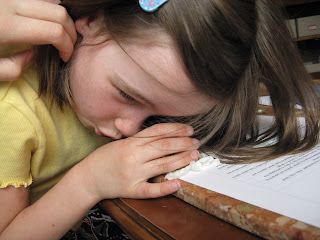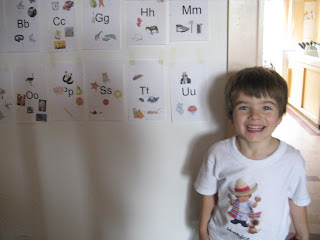Did you read my first preschool post yet? If you didn't, then go
take a look at that first. It explains my overall preschool philosophy and the first and most important things that I think preschoolers should be doing. More important than what I will share in this post, actually.
Read it? Good. So let's move on...
 |
| The cheesy "I'm so excited" smile... |
Disclaimer!
...but one more little disclaimer before we do. =) Please know that this post is merely descriptive of what we are doing, not something that is meant to be prescriptive for all households. Every child is going to be ready for doing number and letter activities at different ages...some will be younger and some will be older. And that's totally normal and fine. Please follow your child's lead with early learning activities. If they are frustrated or uninterested in what you are presenting to them, then back off for awhile and try again later. The preschool and early elementary years are primarily for developing a love of learning, so don't kill it by pushing your child too much or too soon.
Also, I have picked and chosen the activities to fit our needs among many of the free, printable preschool curriculum sets out there. I don't use any of the programs mentioned below in their entirety,
nor do I recommend doing so. But I still mention them here as I find them good sources to pick and choose from when looking for actvities for preschoolers. Go ahead and browse these sites and see what you can find to meet the goals you have for your child!
 |
Working with Sandpaper Letters and Vowel/Consonant Cards
|
Coming Up with a Plan
Before James and I started 'school', I thought through what skills he already had. He knew all of the capital letters by sight, and about half of the lower case. He had a fairly good sense of print awareness from all of the reading we had done together (
here is an interesting article on how to help your child develop print awareness). He knew basic shapes and colors, and could count up to at least 10 by rote. He had better fine motor skills that you might expect from a not-quite-4-year-old boy.
Based on that, I decided to focus our 'school time' on these areas:
- Letter recognition, especially associating upper case and lower case letters with each other.
- Phonemic Awareness - letter sounds/phongrams and activities to introduce the idea of blending sounds together
- Tracing
- Associating numbers with actual amounts
The Early Years Chart at SCM might give you some ideas of where to begin with your child if you're not sure where to start. I also really like
Ruth Beechick's book The Three R's (especially the Reading section) for ideas of how to begin teaching basic skills to young children.
 |
| Going on a Letter Hunt... |
Letter Recognition
For correlating upper and lower case letters, we are using the Bottle Cap Letter Match cards from the
Confessions of a Homeschooler Letter of the Week curriculum set. I print the card with lower case (or upper case) letters, and give him the opposite type of letters to match up. Each 'letter' set has a different card, the link here goes to the letter D. You can find all of the Letter of the Week posts
here with each individual activity available as a free download, or you purchase the complete set in a single download
here.
We also use the
Letter Hunt stories from Confessions of a Homeschooler.
We also have some things like a Lauri Foam puzzle set and a set of Montessori sandpaper letters that we play around with.
 |
| Letter Cut and Paste |
Phonemic Awareness
As advised in Denise Eide's book
The Logic of English, I am presenting James with all of the sounds that each letter can make right from the get go, rather than just the primary sounds. So, rather than just telling him that 'a' just says 'a' like in apple, we talk about how it also says "ay" and "ah". (You can listen to Denise Eide's talks on the Logic of English
here (scroll down until you see Denise Eide) for free, or purchase her book
Uncovering the Logic of English on Amazon, which explains all of the sounds, phonograms, and spelling rules in the English language. Fascinating stuff, at least if you are a nerd like me!) We also play games to help James develop phonemic awareness - an auditory awareness of sounds and how they are put together. There is a great
list of ideas on the Logic of English website to give you an idea of what I mean. We use a basic,
Montessori-style 3 part lesson when introducing new letters and sounds.
We have also played around with some activities for matching initial sounds with the correct letter:
Vowel and Consonant Cards from
Homeschool Creations
Alphabet Cut and Paste Sheets from
Homeschool Creations
Phonics Worksheets, part of the
Raising Rock Stars Kindergarten Curriculum from 1+1+1=1 (each letter set includes one of these worksheets)
 |
Tracing
|
Tracing
For tracing, we use the Montessori sandpaper letters, as I already mentioned. We are also using the "Getting Ready" worksheets which you can find as part of the
Raising Rock Stars Preschool Curriculum sets on 1+1+1=1 (scroll down to download the set for each letter of the alphabet). James also likes tracing the letters at the beginning of each row on the Phonics Worksheets linked above.
Numbers
For numbers practice, we use a set of homemade sandpaper numbers and the unit blocks from Michelle's Math U See curriculum (but any kind of counters will do). I have also printed off a few of the counting games that are included in the
Confessions of a Homeschooler Letter of the Week Curriculum linked above, just to mix things up and keep them fresh since we typically spend a week or two on the same set of numbers. James knew most of his numbers by sight before we started, so we have primarily worked on matching quantities with the corresponding numeral, counting out various quanities, and one-to-one correspondence. We started with just 0-3, and have gradually worked our way up adding a new number or two at a time, again following the basic Montessori 3 part lesson format. I have debated starting him on Math U See's Primer level, but the verdict is still out on that one. Mostly because I hate to BUY something when there is so much free stuff out there...
Every once and awhile we will use the Color and Shape/Following Directions sheets that are part of the
Raising Rock Stars Kindergarten sets as well.
 |
| Matching numbers and amounts |
Practical Considerations
I like to print off about 5 'letters' worth of activities at a time so I am not having to constantly return to the printer. I slip all of the printable sheets we use into page protectors and we use dry erase markers to complete them. That way we can re-do them as many times as we want. I keep all of his old sheets in a binder that he can choose to revisit if he is looking for something to do while I am working with Michelle. (All of my kids also seem to think it is way, way cool to use dry-erase markers on stuff!)
On a typical day, we 'work' for 15-20 minutes. I choose 1 or 2 of the letter/alphabet activities and a math activity for us to do together. We don't necessarily do work everyday, especially if he is engrossed in something else at the time. And we always try to quit while we're ahead! Certainly we stop if he is getting frustrated, but even better yet is to try to read his thoughts a little and quit for the day before he reaches that frustration point.
Anyhow, I hope this has been helpful! Please feel free to ask if you have any other questions!


































